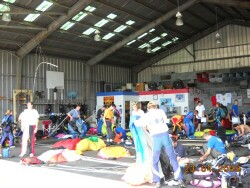
L. David Roper, http://arts.bev.net/RoperLDavid/; roperld@vt.edu
04-Aug-2009
During five years (1995-2000) of flying a Cessna 170 I never was tempted to jump out of an airplane. However, on Saturday 23 May 2009 I did jump out of an airplane along with my wife, Jeanne Baril Roper, her son Christopher Howard and her brother Peter Baril, to celebrate Pete's 60th birthday.
We drove to Middle Peninsula Airport in Mattaponi, Virginia next to the York River to join many other jumpers at West point Skydiving Adventures, arriving at noon. The company is located in a metal hanger to the left of a new airport terminal building. We stepped over many parachute lines where people were sitting and lying on the floor loading parachutes, also called canopies (similar to a rectangular parasail), into cloth back packs on our way toward the registration window in the back:

We filled out many documents signing our names many times and initialing about twenty clauses relieving the company from any responsibility for our skydives.
While waiting for about 15-minutes of training and our flight we watched many jumpers prepare to jump, board the large plane with a back ramp on a taxiway in front of the hanger and make their jumps, landing softly on a grassy area between the taxiway and the runway. Watching them increased my confidence that the jump would be safe.
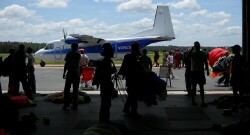 |
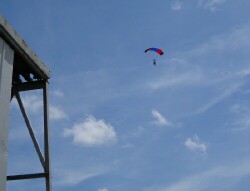 |
Finally, at about 1:30 we received detailed instructions from Henrik, who turned out to be Chris' instructor. We were fitted, after several tries for size, with jump suits and a massive harness, that has 4-point strong and tight connections to the harness of the instructor that would be behind us. The harness was so tight that it was difficult to walk to the plane and step up onto the rear ramp. We wore a wrist altimeter on the left arm and were instructed to watch it on the way down. There are two rip cords for the parachute, one of which is on a long extension that was hooked onto our harness. We were instructed to start to pull it at 6000 feet, so that the chute would be actuated at about 5000 feet. We wore a leather helmet with plastic goggles, which allowed me to keep my glasses on which I had secured with a strap behind.
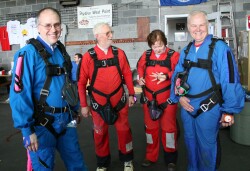 |
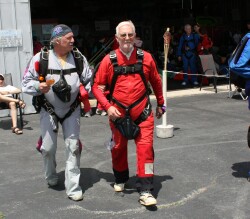 |
My instructor was Clarence, a veteran of many thousands of jumps since 1976. He and I sat near the front of the plane that carried 32 jumpers. We four were the only tandem jumpers on our flight sitting opposite each other with our four instructors. Our four videographers ("vidiots") sat on the floor between us so that they could interview us on the plane. The vidiots wore a special helmet with a still camera on top and a movie camera on the side. They had a tube in the mouth, which I think was used to actuate the still camera.
At the rear of the plane were twenty single jumpers, some of which might have been a group doing formation jumping. (We saw several such groups practicing their practicing their formations on the ground before they boarded the plane.)
At 12,000 feet the single jumpers started jumping. I think it was at about 13,000 feet when we jumped. Before moving toward the back of the plane we were very tightly attached at the four harness points to our instructors such that it was difficult to walk.
Peter jumped first to celebrate his 60th birthday, Jeanne was second, I was third and Chris was last of all jumpers. The vidiot positioned himself backward to the left at the exit so that he jumped backward just as we jumped forward, filming us all the time, including many still photos as well as a movie. My vidiot was Chris, who did an excellent job of catching the important features of my dive.
We were instructed to fold arms over the chest with feet together and to arch the body backward when the instructor pushed off. This causes a back flip so that the body faces downward. Then a small drogue parachute is released from the instructor's back to hold that face-down position; it slows the fall speed from 160 mph to 120 mph:
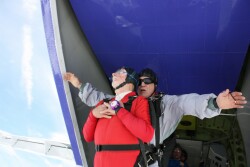 |
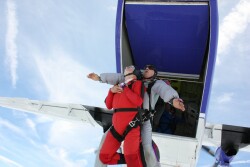 |
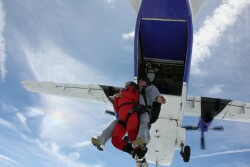 |
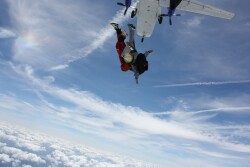 |
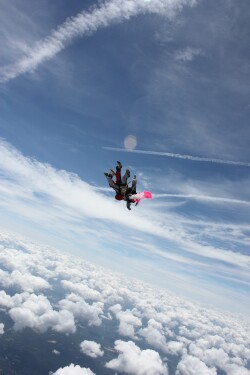 |
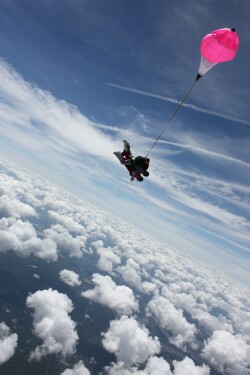 |
The whole-body force of the air is somewhat like belly flopping into a swimming pool from a high diving board, only it keeps on buffeting the body until the parachute is opened. (Afterwards I felt like fists had been pummeling my whole body in front.) I tried pushing my arms out, but that felt too unstable, so I kept them bent forward, which made my dive more stable that the flights of my three companions. I felt like my helmet was going to be pulled up off of me, so I put a hand on top of it part of the time; it should have been attached tighter.
We were instructed that if we forgot to watch the altimeter, the instructor would tap on the left shoulder at 6000 feet. Sure enough, I was so engrossed in the buffeting and the view that I forgot. Clarence grabbed my left arm and pushed it toward my face. I saw 6000 on it, so I quickly pulled the rip cord with my right hand (3rd picture below).
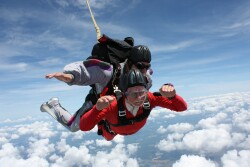 |
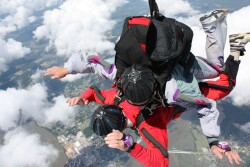 |
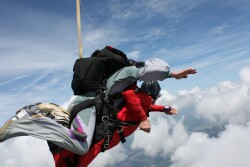 |
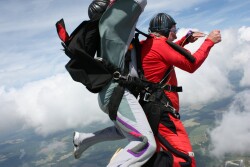 |
The time between jumping out of the plane and pulling the rip cord is about one minute, but it seemed much longer. My three companions did not pull the rip cord; their instructors did, of course. (There is another backup parachute that automatically releases at 1000 feet if it has not already been actuated and if the main parachute did not open.)
The huge force on the body by means of the harness straps when the parachute opens is hard to describe; it sort o9f feels like your internal organs are moving down further in the body. Then the contrasting experiences of calm floating and still large forces of body weight of the harness on the body takes a while to acclimate.
My vidiot did not deploy his chute until about 3500 feet, so he quickly fell beyond us such that he could not take any more pictures until we approached the landing area where he was waiting.
Shortly later Clarence told me to take the two parachute control straps with him and do a few turns. He did a 360° spin, which made me quite dizzy. We did a flare together by pulling down on both straps to spill air out of the chute for a moment of free fall. I am not sure how long it was from the time the parachute opened to landing; I think that it was about 5 minutes.
Clarence had me pull up my feet by grabbing grips just below the knees, so that his feet touched ground first. I did not let my feet down soon enough, so that I fell forward on my knees. I thought that I was going to fall on my face, but Clarence adjusted the chute so that I did not:
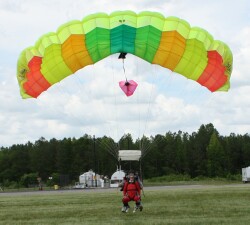 |
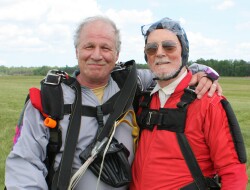 |
I helped Clarence gather up the parachute and carry it to the hanger. (Later I saw Clarence practicing formation diving with ten other divers before they went up. Our dive was his 3rd of the day; he planned to do six.)
I was very impressed with the skills of Clarence, my instructor, and Chris, my vidiot. Chris took excellent still pictures, as can be seen above. The movie was excellent, also.
It took about 30 minutes for our videos and still photos to be put on a CD. My video is available for viewing on the Internet.
My body ached vaguely for hours afterward and I felt somewhat exhausted. If you want a good stress test of your body, especially your heart, tandem jumping is it!
I want to do it again for Jeanne's 70th birthday in November.
Lyrics for the music "Not for Me" written by Bruce Parker after seeing this web page:
Sky-Diving’s Meant for You
But Not for Me.
I See Jeanne Likes It Too
No Way for Me.
I'll Kiss the Earth I Love
Caress It Like a Dove
Instead of Falling Down
From Miles Above.
With Feet on Earth I Stand
And I'm Alive
To Greet You with a Hand
When You Arrive.
So, Try to Understand
Skydiving May Be Grand
For You and Jeanne, A Spree
But Not for Me.